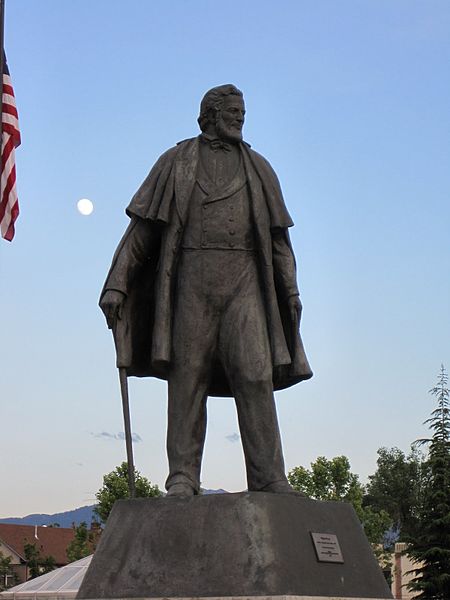
No. No. Darn it, I just can’t get tonight’s ugly, toxic fiasco out of my head.
The just-concluded presidential debate, in my judgment, substantially strengthened the case for (a) restoring the separation of powers between the three branches of the federal government (e.g., by shrinking the power of the executive branch), (b) greater federalism — that is, returning power from Washington DC to the states and to local communities — and (c) limiting the power of government overall.
“I love the government and the constitution of the United States, but I do not love the damned rascals who administer the government.” (Governor Brigham Young, Journal History [8 Sep 1851] 3-4)
***
While I’m thinking of Brigham Young, I’m reminded of an interesting episode recounted in his important book Religion of a Different Color by Paul Reeve:
An early mixed-race (Black and American Indian) member of the Church named William McCary — as it turned out, a rather tenuous and somewhat erratic and even unbalanced fellow, who ultimately didn’t endure faithfully to the end — had encountered racial prejudice among some Church members.
In response to this, President Young counseled the Saints to “use the man with respect.” (The verb to use is employed here in a somewhat archaic sense common in Shakespeare. See below. In today’s English, we would employ the verb to treat.)
But some problems persisted. And he continued to complain.
Was he in some way sub- or even non-human?
“Its nothing to do with the blood,” replied President Young, “for of one blood has God made all flesh.”
Professor Reeve comments on this exchange:
“It was an echo of the same New Testament verse (Acts 17:26) that [Joseph] Smith quoted in his presidential platform three years earlier. Both drew upon the Bible to assert a broad commonality among humankind and were simultaneously acknowledging a wider racial debate then animating the scientific and Christian communities. In paraphrasing Acts 17:26, Young and Smith were referencing an important verse then commonly cited among nineteenth-century Christians. Believers used the verse to defend against a polygenesis theory then stirring scientific arguments about the origins of the various races. Scientists who promoted the polygenesis theory believed that there were multiple independent creations rather than just a single biblical creation. Each creation gave rise to a new race, which meant that whites and blacks were in fact from different species. Even though the two species could biologically reproduce, one argument was that an innate repugnance against interracial mixing was intended to preserve ‘species distinction.’ Those who violated the innate repugnance were really violating nature, which was a sure sign of their moral degradation. Physical degeneracy followed and within a few generations the offspring of such unions would be sterile.” (See W. Paul Reeve, Religion of a Different Color: Race and the Mormon Struggle for Whiteness [New York and Oxford: Oxford University Press, 2015], 128-131.)
(For historical examples of “scientific racism” in the pages of Scientific American, no less, see my recent article “Reckoning with the Mortally Inevitable.”)
It’s fashionable, of late, to demonize Brigham Young as a racist, even a vicious one — and, in some cases, essentially to forget that there was anything else to the man.
I resist this.
He wasn’t perfect, of course.
Nor is Russell M. Nelson. Nor am I. Nor are his critics.
“Use every man after his desert,” wrote Shakespeare (in Hamlet II.ii), “and who should ‘scape whipping?” Or, to paraphrase: Treat everybody purely according to his or her merits, and who wouldn’t be worthy of censure or even punishment?
In racial matters, Brigham Young said some things that jar us today — to put it mildly — and that we cannot endorse. There’s no denying this. He was, as we all are — even the prophets among us — a man of his time and culture and background.
But he was a good man, indeed a great man, a sincere disciple of the Lord and a prophet who sought to do God’s will.
I choose to stand with him. “The soul that on Jesus hath leaned for repose I will not, I cannot, desert to his foes.” And, on the specific racial issue described above, President Brigham Young was — notwithstanding the dismissive stereotype of him that’s currently in vogue — on the side of the angels.










